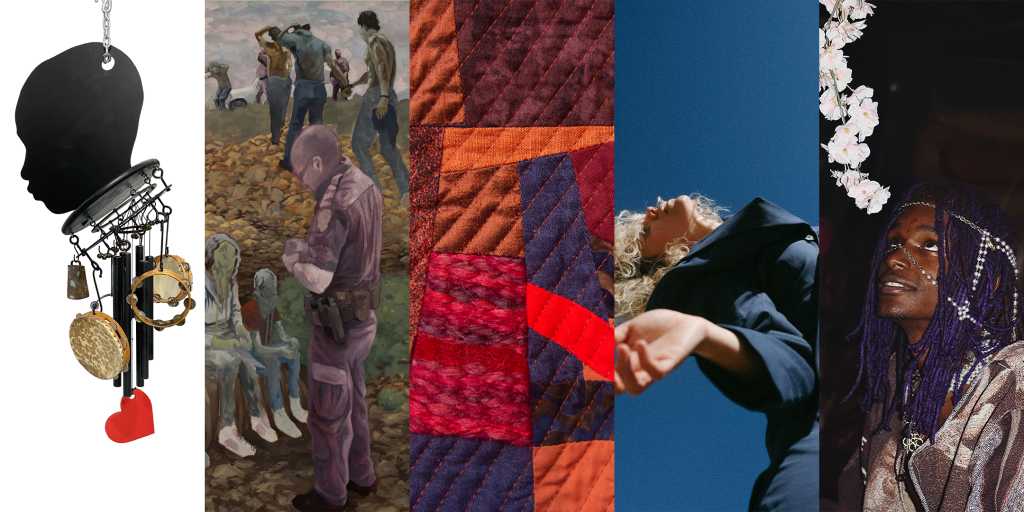
KANSAS CITY, MO, FEBRUARY 13, 2024: Charlotte Street is pleased to announce the 2024 recipients of the 2024 Visual Artist and Generative Performing Artist Awards, honoring the outstanding achievements of Kansas City contemporary artists. This year, Charlotte Street’s Visual Artist Fellows are Kevin Demery, Juan Diego Gaucin, and Aleah Washington. Recipients of the Generative Performing Artist Fellowship are Haley Kostas and Unique Hughley.
Since 1997, Charlotte Street’s Visual Artist Award has supported 110 outstanding artists living in Kansas City through annual, unrestricted cash awards, with a total of $841,500 now distributed directly to visual artists. This year’s Visual Artist Fellows highlight the “haunting specter” of the present in Demery’s interrogation of Black historical narratives, Gaucin’s figurative oil paintings of the migrant experience, and Washington’s quilted compositions resembling the historical maps of redlining in Kansas City.
Charlotte Street launched its Generative Performing Artist Awards in 2008 as a parallel program to the Visual Artist Awards. Charlotte Street continues to act as a catalyst for discovering and supporting contemporary performing art and has now distributed $310,000 to 31 performing artists whose works expand the genres of performance. Generative Performing Artist Fellow Kostas infuses the psyche in her movement and choreographic works, while Hughley cultivates positive resistance and radical empathy through poetry and visual storytelling.
Each artist will receive an unrestricted cash grant of $10,000 and recognition by Charlotte Street throughout 2024—including announcements to media, web-based marketing and promotional efforts, and special events. Visual Artist Fellows are further recognized with a professionally curated exhibition premiering at The Nelson-Atkins Museum of Art in 2024.For the majority of the fellows, this is their first opportunity to exhibit work in a prominent museum setting.
The 2024 Charlotte Street Awards were selected through a competitive process beginning with an open call for applications from artists based in the five-county Kansas City Metro Area. Selections were made by a panel of jurors consisting of renowned arts professionals. Jurors participated in in-person interviews, presentations, and studio visits, resulting in the selection of 11 finalists for the Visual Artist Awards and 11 finalists for the Generative Performing Artists Awards.
VISUAL ARTIST AWARD FELLOWS

KEVIN DEMERY
I’ve always found poetry in objects that convey multiple histories, objects that, through context and placement, drastically change meaning. For this reason, I use a wide variety of media rooted in traditions of assemblage. My practice triangulates intimate examinations of childhood, racial subjugation, and autobiography. I employ a kitsch-like aesthetic that often veils the weight of the subject matter intentionally. I traverse a multitude of applications and presentations to draw the viewer into an environment with each piece. This is done as a means to evince the power of the materials and imagery used to evoke curiosity into the narratives that lie within them. An example of how I employ these methods is my most recent sculptures featuring a collection of larger-than-life-size windchimes. The centerpiece of the sculptures features the likeness of George Stinney Jr., a deceased African-American child who was tried, falsely convicted, and executed in Alcolu, South Carolina, in 1944. The windchimes I make appropriate the final photo taken of George at a profile, which was his mugshot post-arrest. I employ the use of his silhouette carved out of ½-inch MDF board to illuminate the one-dimensional character he was afforded in life. George’s silhouette resembles so many black youths that the image itself becomes symbolic of the collective. Many of my works reference history independent from a particular narrative and speak as a form of poetry to larger cultural experiences. I make these objects to interrogate Black historical narratives, acting as a haunting specter to the sociopolitical backdrop in which I find myself. I’m drawn to the arrangement of symbols to illuminate further the nuances of the histories I awaken. In this, I find links between the objects I create and my experience growing up as an African-American youth amid atmospheres riddled with political inertia, poverty, and violence.

JUAN DIEGO GAUCIN
I would consider myself a figurative oil painter with expressionist tendencies. Having experienced the process of immigrating to the United States early in my life, I am intimately drawn to work that explores the hardships endured by all migrants, and the Latino community in particular. Strong experiences with racism, alienation, and prejudice, have inspired a desire to enact positive change through art and empathy. My artistic aim is to generate compassion, re-sensitize viewers to the reality of human suffering, and resist the culture of hate that continues to linger in the hearts of many by transforming news media and journalism into visually striking abstracted paintings. The focus is then shifted away from an unethically framed politically motivated recounting of events to one that records the lived experiences and emotions from the perspective of the people themselves. I strive to make it difficult to remain uninformed of the humanitarian crisis unfolding along many borders, including our own southern border. The constant stream of both accurate and inaccurate news stories creates a drastically polarized environment in which what one chooses to believe is almost completely dependent on the political ideologies they adopt. Art is uniquely suited to dispel polarization by reminding the viewer, through visual language, that empathy for the suffering being inflicted on these individuals should supersede any consideration of politics. In being confronted with the reality of the inhumane nature of child separation, denial of asylum, and general villainization of migrants, it is my hope that they will be moved toward positive action so that the suffering of human beings is diminished.

ALEAH WASHINGTON
As a textiles artist, creating utilitarian items that are decorative represents the importance of my hand in people’s daily lives. Keen with identity, my work presents moments of vulnerability and leisure as private home items are revamped. I collect various disregarded fabric blends that are then cut and pieced together, transforming them while producing less waste. I make functional art pieces using color as a way to invoke feelings through proximity playing off the reality of gentrification. My use of patterns in solid areas shows the impact of redlined communities and examines the current effects of historical maps. Lower-income communities are intentionally separated from necessary resources to push them from their homeland. Existing disrupted lands are represented through my take on collaging small cuts of fabric together, while oppressive systems make new pathways with traditional quilting methods. The meaning of home is personified and expressed through mixing curtains, home décor, and nonfunctional clothing items. The fabrics I source correlate to different cultures and histories, but when combined they create unity and demonstrate a new strength than in its last form. Kansas City’s history of color-coded redlined maps that discriminate influences the necessity to make oneness through proximity. J.C. Nichols founded suburbs and created these maps that determined the value of communities for more than 230 cities across the U.S. that racially divided neighborhoods. This psychological effect of time and division is explored by bringing back value to disregarded fabrics while urban decay is a lasting outcome. Without always looking for a direct answer, I use a playful take on incorporating vivid colors and repetitive techniques that add to the experience of touch that affects memory, mood, and comfort level.
GENERATIVE PERFORMING ARTIST AWARD FELLOWS

UNIQUE HUGHLEY
My artistic journey is a fusion of crafted poetry and visual storytelling, where I explore the realms of hope, resilience, and collective action. The core of my work resonates with the ethos of Hopepunk—a literary genre that champions narratives steering away from bleakness to focus on characters fighting for positive change, kindness, and communal responses to challenges. Hopepunk spotlights protagonists devoid of superhuman powers, yet remarkably instrumental in saving the world through collective efforts. These principles deeply resonate with the core of my creative process, driving the formation of my artistic ideals. My creations serve as a vessel for these intentions, aiming to inspire and uplift through the power of words and visual representation. Hopepunk’s narrative of positive resistance, radical empathy, and the celebration of collective response strongly influences my poetic expressions and artistic endeavors. In crafting my work, I blend various mediums, utilizing both traditional and digital tools. I infuse my poetry with visual elements, presenting them akin to music videos, and engage in community events and outreach, fostering involvement and resonance with the themes of hope and resilience. The method of my artistic process involves a symbiotic relationship between the written word audio engineering and visual components. This fusion amplifies the message, allowing my audience to engage on multiple sensory levels, drawing them into the worlds I depict in my poetry. In my artistic journey, I’ve cultivated a platform both in my local community and online, where I craft my poetry akin to music videos, engage in local events, and conduct community outreach to foster involvement. I strive to encourage audiences to recognize the power of optimism, goodness, and the collective will to instigate positive change. The materials I employ are diverse, ranging from traditional pen and paper to digital illustration tools, combining the two seamlessly. The process involves meticulous weaving of words, audio, and visuals to evoke emotions and provoke contemplation, inviting the audience to join me in embracing the spirit of Hopepunk. Through my artistic endeavors, I aim to create a space where the audience is not merely a spectator but an active participant in the exploration of resilience, kindness, and the collective pursuit of a better world.

HALEY KOSTAS
My work as a Generative Performing Artist is creating both site-specific and staged movements with psychological and social intent through physical narratives. As a multidisciplinary dance artist and choreographer with a growing background in psychology, my work pushes contemporary dance into new forms, expanding the medium’s boundaries through contemplative practices of movement, sound, and psychology. I collaborate with multiple artists from various mediums to break down the confines of my art form, with the goal of allowing more people to experience movement and reconnect with their bodies. I use the body as a physical and mental conduit for energy and thought to pass through, initiated by illustrative and free-form movements to discover the shape in (e)motion and to unlock the mysteries of the mind. I target the ways the body responds to multisensory stimuli and tap into how our bodies function as a map and a memory of our emotions. The main influence on my work is the combination and intersection of deviance, environment, and human behavior. Out of my own discomfort with social settings, I’ve always been fascinated with breaching norms and societal expectations that restrict self-actualization and honesty within groups and interpersonal communication. My sensitivity to social limits and the constrictions they put on connection has given me the ability to expose quiet but known dysfunctions in social dynamics and the psychological space they occupy. Growing up in dance culture has shown me how dysfunctional group dynamics can be and how these environments affect behavior and impact cognition. While my own battle with mental illness has informed much of my work, it has also taught me that my medium has healing capacities for both myself and others. I’ve found entering the dream state of surrealism to explore the psyche yields more powerful healing than traditional storylines of dance theater. Being immersed in movement, sound, and a safe space gives us a way to confront and address the physical and emotional pain of the human experience. My process involves movement meditation as a practice of mindfulness, training attention, and physical awareness. This exhausts external attempts of movement to open up a more internal and intentional approach to form. Choreographically, I simulate a social setting informed by the shape of the environment or interactive dynamic of one or more people or objects. I focus on the transitional moments people tend to avoid and how transitions are applicable to continuous movement. My work is designed to evoke individual awareness within artistic social gatherings with the hope of moving through what we feel, think, and experience together.
VISUAL ARTIST AWARDS JURY
Hakim Bishara – Senior Editor, Hyperallergic (NYC)
Taylor Jasper – Assistant Curator of Visual Arts, Walker Center (Minneapolis, MN)
Stephanie Fox Knappe – Sanders Sosland Senior Curator, Global Modern and Contemporary Art, Head American Art, The Nelson-Atkins Museum of Art (Kansas City, MO)
Maria Elena Ortiz – Curator, Modern Art Museum of Fort Worth, TX
GENERATIVE PERFORMING ARTIST AWARDS JURY
Rachel Adams – Chief Curator + Director of Programs, Bemis Center for Contemporary Arts (Omaha, NE)
Nigel Campbell – Artistic Director, Gibney Center (NYC)
Helen Gillet – Cellist (New Orleans, LA)
Kholoud Sawaf – Independent Theater Director (Fayetteville, AK)
For interview requests with the Charlotte Street Fellows or other press inquiries, contact Marketing + Communications Manager Hope-Lian Vinson at [email protected].
ABOUT CHARLOTTE STREET
Charlotte Street centers Kansas City’s most forward-thinking visual artists, writers, and performers—acting as the primary incubator, provocateur, and connector for the region’s contemporary arts community, and its leading advocate on the national stage. Since 1997, Charlotte Street has distributed over $2.5 million in awards and grants to artists and their innovative projects, and connected individual artists to each other and to the greater Kansas City community. For more information about Charlotte Street, its awards, programs, and initiatives, visit www.charlottestreet.org.
###
View the Press Release as a PDF here.



